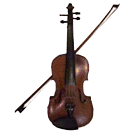 |
In traditional music notation you will find a lot of Italian musical terms.
When notating music, it is custom to write them at a predefined position using a predefined font.
![]() tempo
oriented tems like adagio
are usually written above the staff (using text type info 1 <h>)
tempo
oriented tems like adagio
are usually written above the staff (using text type info 1 <h>)
![]() dynamic
oriented terms like crescendo
are usually written below the staff (using text type info 2 <i>)
dynamic
oriented terms like crescendo
are usually written below the staff (using text type info 2 <i>)
|
Abbreviatura | |
|
A cappella |
Voice only - without instrumental accompaniment |
|
Accaciatura |
short grace note |
|
Accellerando |
accellerate tempo |
|
Adagio |
Slow tempo with expression |
|
Ad lib / ad libitum |
'as you like it' |
|
Agile |
Quick / lively |
|
Agitato |
Agitated |
|
Al Fine |
Move to end. |
|
a bit fast and lively allegro | |
|
Allegro |
Fast and lively |
|
Allegro agitato |
Fast and agitated |
|
Allegro con brio |
Fast |
|
Allegro con fuoco |
Fast and furious |
|
Allegro con spirito |
Fast, with spirit |
|
Allegro moderato |
Moderately fast |
|
All ottava |
one octave higher then notated |
|
Andante |
Moderately slow |
|
Andantino |
Andante-like; might be faster or slower than andante |
|
Animato |
Lively |
|
Arco |
Played with the bow (contrary to plucked, pizzicato) |
|
Animando |
Getting livelier |
|
Apoggiatura |
long grace notes |
|
A tempo |
Play in previous tempo |
|
Assai |
'Very' as in Allegro assai |
|
Attacca |
Start at once |
|
Ballabile |
To be danced on |
|
Basso continuo |
Accompaniment using clavichord and bass / violoncello |
|
Bel canto |
Sung as in Italian opera 18/19e century |
|
Bruscamente |
Brusque |
|
Calando |
Diminshing |
|
Tail piece | |
|
Cambiare |
Exchange (instrument) |
|
Cantando |
Sung |
|
Cantabile |
Like being sung |
|
Capriccio |
Free form passage, showing skills |
|
Chiuso |
Closed (horn) |
|
Contra |
Against |
|
Col legno |
Playing a violin /cello using the wooden side of a bow |
|
Coperti |
Covered (drum, muted with a cloth) |
|
Gradually getting louder | |
|
From the beginning | |
|
Decrescendo |
Gradually getting softer |
|
Gradually getting softer | |
|
Dolce |
Sweet, soft |
|
Starting from the sign | |
|
Entrata | |
|
Played differently in time (mostly longer than notated) | |
|
End | |
|
Forte |
Loud |
|
Very loud | |
|
Forzando |
Using strong accents |
|
Forzatissimo |
Using very strong accents |
|
Furioso |
Vurig, heftig, woedend |
|
Grave |
Serious |
|
Gliding | |
|
Imitando |
Imitating |
|
Interludium |
Intermediate piece |
|
Intermezzo |
Intermediate piece |
|
Tie notes together | |
|
Lento |
Slow |
|
Martellato |
Hammering |
|
Marcia |
In strict tempo at a marching pace (120 bpm) . 'a la Marcia' |
|
Meno |
Less |
|
Moderato |
Moderate tempo |
|
Molto |
More |
|
Mosso |
Lively |
|
Parlando |
Spoken (not sung) |
|
Passione |
With passion |
|
Piu |
More |
|
Poco |
A little bit |
|
Portato | |
|
Very soft | |
|
Pizzicato / Pizz. |
Plucked (instead of bowed) |
|
Prelude |
Introduction |
|
Prima vista |
At first sight reading |
|
First time (1) | |
|
Rallentando |
Getting slower |
|
Rapido |
Very fast |
|
Religioso |
Religious |
|
Rinforzando |
Emphasizing a group of notes |
|
Ritardando |
Getting slower |
|
Ritenuto |
Decelerating |
|
Rubato |
Free in tempo |
|
Scordatura |
Using a non-standard instrument tuning |
|
Second time | |
|
Senza tempo |
No fixed tempo |
|
Senza replica |
Without repetitions |
|
Sforzando |
Emphasizing one note or chord |
|
Sforzato-piano |
sfp first strong, immediatly thereafter soft |
|
Spiccato |
With a bouncing bow - every note accented |
|
Played (much) shorter than notated | |
|
Play a note as short as possible | |
|
Stringendo |
Getting faster, stronger |
|
Tacet |
Silent (no chords) |
|
Toccata |
Free style music piece |
|
Somewhat louder | |
|
Repeating short notes | |
|
Tutti |
Everyone together |
|
Unisono |
Single voiced |
|
Veloce |
Fast |
|
Vibrato |
Pitch modulation (speed and amplitude may vary) |
|
Vivace |
Lively, pleasantly |


